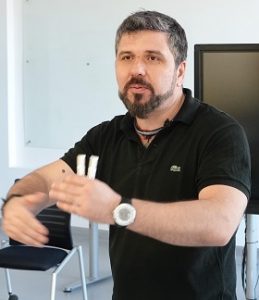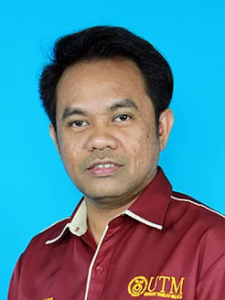 Assoc. Prof. Dr. Predrag K. Nikolic
Assoc. Prof. Dr. Predrag K. Nikolic
Title: Robot-Robot Interaction: Metaphysics of The Machines
Bio:
Dr Predrag K. Nikolic is Associate Professor and Principal Investigator at School of Creativity and Art, ShanghaiTech University, Shanghai, China and Adjunct Professor at College For Creative Studies, Detroit, USA. He is an experimental designer, interactive media designer, digital media expert and a media artist who holds a PhD in Digital Media and an MBA. His research focuses on intelligent interfaces, robot creativity, design for behavioural changes. mixes experiential reality and smart living environments to engage an audience in new types of interactive experiences in future cities. His design and artworks, such as Botorikko, MindCatcher, InnerBody, Ciklosol, Before & Beyond, Vrroom, Robosophy Philosophy, Digital Lolipop, In_Visible Island were exhibited worldwide and presented at the Ars Electronica Festival, SIGGRAPH, SIGGRAPH Asia, Technarte USA, Technarte Spain, Singapore Science Center, Hong Kong – Shenzhen Design Biennial, Maison Shanghai, National Museum of Applied Art in Belgrade, National Museum of Education in Belgrade.
Before joining ShanghaiTech University School of Creativity and Art, Predrag Nikolic was an Associate Professor at Shantou University School of Art and Design China, Dean of Faculty of Digital Production at Educons University Serbia, Visiting Professor at Bergen Academy of Art and Design Norway, Researcher at Aalto University Finland, Global Digital Director at Grey Germany, Global Digital Director at J. Walter Thomson Germany, Global Head of Digital at Ogilvy Greece, Head of Digital Marketing at Groundlink USA, Consultant at Yahoo USA and Managing Director at the JadePremier United Kingdom. During his career in a creative industry, he conceptualized and designed digital media presence for the clients such as Telenor, IBM, Nestle, H&M, Mars, Coca-Cola, Credit Agricole Bank, Yahoo, Czech Airlines and many others.
Dr Predrag K. Nikolic has published numerous research papers in the field of artificial intelligence aesthetics, robot creativity, robot–robot interaction, design for behaviour change, collective creativity, mix-experiential reality, multi-sensory interfaces, interactivity and interface design. He lectures at universities and giving speeches at international conferences such as EmTech MIT, Technarte, SIGGRAPH, INTETAIN, MobilityIOT, Smart City 360, etc. Professor Nikolic is Editor-In-Chief for EAI Endorsed Transactions on Creative Technologies Journal, European Alliance for Innovation Fellow, listed artist in Leonardo Electronic Directory, SIGGRAPH Digital Arts Community Member, international exhibitions curator and serves on many conference committees.
Abstract:
Creativity and the act of creating art are some of the greatest challenges the new generation of artificial intelligence models are exposed to. Still, humans selfishly endeavour to keep it as its distinctive capability. Nevertheless, by creating AI agents to achieve and exceed the performances of humans, we need to accept the evolution of their creativity too. The recent development in the field of machine learning encounters robots’ interesting and creative responses in the domains of dance, music, painting and drama. Hence, there are two possible directions toward the future development of robots’ creativity, either to replicate the mental processes characteristic for humans or to liberate machine creativity and leave them to evolve their own creative practices. By
making artificial intelligence agents autonomous, we are shifting AI as a creative medium beyond traditional artistic approaches and interpretations. The medium as such is not any more in complete control of an artist. It is divided between humans and robots and their mutual contribution to final creation. Hence, we are in need of extending our aesthetical and conceptual judgments from solely human to human and robot creativity analysis.
Professor Nikolic will present several of his projects where he is using robot-robot and human-robot-robot interaction design toward the creation of novel user experience phenomena.
 Dr. Hoshang Kolivand
Dr. Hoshang Kolivand
Title: Current and Future of Directions of Augmented and Virtual Reality
Bio:
Hoshang Kolivand is Senior Lecturer in Computer Graphics at the Department of Computer Science, Liverpool John Moores University, UK. He received his MSc degree in Applied Mathematics and Computer Science from Amirkabir University of Technology, Tehran, Iran, and his PhD from Universiti Teknologi Malaysia (UTM) in 2013. His background is in 3D maths & Computer Graphics in particular Augmented and Virtual Reality. Over 150 international publications in the area of 3D visualisation, immersive technology & human Computer Interaction. A global leader in this field invited to address the current & future advances of immersive technology in several high ranked international events.
Abstract:
There is no doubt that Augmented and Virtual Reality(AR/VR) has changed the world recently and has the potential to become a fascinating widespread requirement in daily life. In about two decades, AR/VR has turned into one of the most attractive topics involved in a variety of topics attempting to obtain satisfactory results. In this speech, I am going to present what I have done so far with AR and VR and new technologies. Current advances and future directions of AR/VR and wearable devices will be discussed with an eye on revenue of this technology How to engage our current research with new technology to enhance our current research will be the next part of my speech.
 Assoc. Prof. Dr. Rui Prada
Assoc. Prof. Dr. Rui Prada
Title: How AI can help games fulfil their purpose
Bio:
Rui Prada is Associate Professor at Instituto Superior Técnico (IST), Universidade de Lisboa and Senior Researcher in the AI for People and Society Research Group at INESC-ID Lisbon. He was co-responsible for the creation of courses on Game Design and Development and the creation of the Specialisation in Games of the Master Program in Information Systems and Computer Engineering at IST. He conducts research on social intelligent agents, affective computing, human-agent interaction, computer games, applied gaming and game AI. He is co-author of the book “Design e Desenvolvimento de Jogos” edited by FCA and was one of the founding members of the Portuguese Society of Videogame Sciences. He is currently the coordinator of the iv4XR EU funded project that researches automated testing of Extended Reality systems.
Abstract:
I will start this talk by discussing the potential of games for serious purposes, sharing some examples of applied games developed by my team. I will continue by discussing the use of Artificial Intelligence (AI) for games. I will discuss how AI can be used in games applied to learning of social skills and how AI can improve the social qualities of artificial agents in games. I will conclude with a discussion of the use of AI for game production, in particular, to generate content and to automate playtesting.
 Assoc. Prof. Dr. Shukor Abd Razak
Assoc. Prof. Dr. Shukor Abd Razak
Title: AR Security and Privacy Risk
Bio:
SHUKOR ABD RAZAK (SMIEEE) is an Associate Professor at the Universiti Teknologi Malaysia. He is the author and coauthor of many journals and conference proceedings at national and international levels. He is actively involved in numbers of research projects in the area of digital forensic investigation, wireless sensor networks, and cloud computing. His research interests also include security issues for mobile ad hoc networks, mobile IPv6, vehicular ad hoc networks, and network security
Abstract:
In AR, users experience realism of virtual and augmented reality by utilizing their biometric data such as iris or retina scans, fingerprints, face geometry, handprints and voiceprints. Users need to keep in mind that there are still many loopholes in AR technologies that could be exploited by hackers to collect personal data. For instance AR technologies can see everything what the user sees and this for sure impose security risks to the users. The talk will discuss security and privacy issues related to the usage of AR in various perspectives and provide suggestions to minimize the risks.


